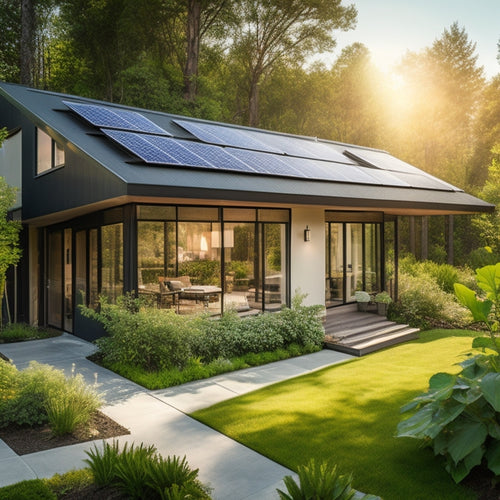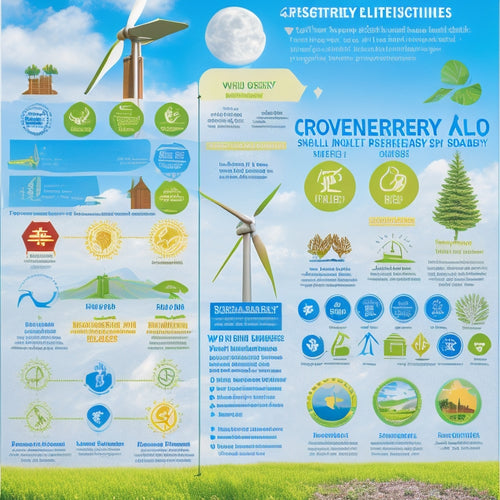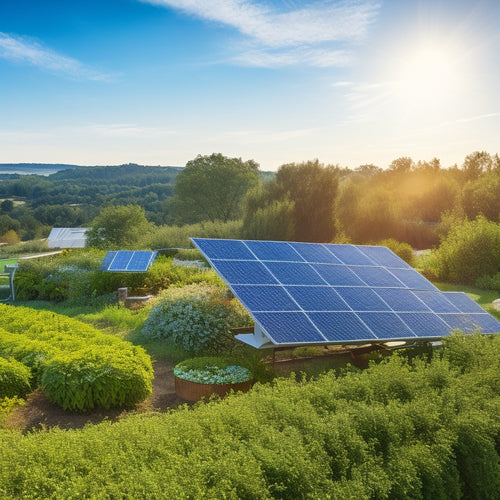
What Are the Main Components of Solar Energy Installation Costs
Share
When calculating the total cost of a solar energy installation, you'll need to take into account nine primary components. First, there are the expenses associated with solar panels, including the type and efficiency of the panels. Next, you'll need to factor in inverters and monitoring systems, which can vary in cost depending on the type and features. Installation labor and overhead costs, permits and inspection charges, and mounting and racking system expenses are also significant factors. Additionally, you'll need to take into account electrical and wiring costs, roofing and structural upgrades, battery storage system expenses, and additional components and accessories. As you examine these components, you'll gain a deeper understanding of what drives the overall cost of your solar energy installation.
Key Takeaways
- Solar panel costs vary by type, with monocrystalline being the most efficient and expensive, and thin-film being the least efficient and most affordable.
- Inverter and monitoring system costs include the type of inverter, efficiency ratings, and monitoring capabilities, which impact overall system performance and energy production.
- Installation labor and overhead costs depend on skilled laborers, electricians, and engineers, as well as permits, insurance, and equipment rental fees.
- Permits and inspection charges, including electrical and building permits, and inspection fees, vary by location and system size, and are essential to include in the overall budget.
- Additional components and accessories, such as mounting hardware, electrical connectors, and monitoring systems, are necessary for a reliable and efficient solar energy installation.
Solar Panel Costs Breakdown
Your solar energy installation is comprised of several key components, with solar panels being the most visible and arguably the most important part.
When it comes to solar panel costs, you'll need to take into account the type and efficiency rating of the panels you choose. There are several solar panel types to examine, including monocrystalline, polycrystalline, and thin-film panels. Each type has its own unique characteristics, advantages, and price points.
Monocrystalline panels, for instance, offer high efficiency ratings (typically 20% or higher) but come at a higher cost.
Polycrystalline panels, on the other hand, have lower efficiency ratings (around 15-17%) but are more budget-friendly.
Thin-film panels are the most affordable option but have notably lower efficiency ratings (around 7-14%).
You'll need to weigh the upfront cost against the long-term energy production benefits when selecting the right solar panel type for your installation.
Mounting and Racking System Expenses
When you're evaluating mounting and racking system expenses, you'll need to assess the costs associated with roof mounting options, which can vary depending on your roof's size, material, and complexity.
You'll also need to factor in ground mounting costs, which can add up quickly if you're dealing with a large solar array or challenging terrain.
Roof Mounting Options
Across various solar energy installation projects, the mounting and racking system expenses account for a significant portion of the overall cost.
When it comes to roof mounting options, you'll need to take into account the type of roof you have and the best solar panel orientation for your location. For instance, if you have a flat roof, you may opt for a ballasted mounting system, which uses weights to secure the panels. On the other hand, if you have a pitched roof, you may choose a rail-based system, which attaches to the roof's rafters.
The roof type factors will also impact the installation process. For example, tile roofs require specialized mounting hardware to avoid damaging the tiles, while metal roofs may require additional structural support.
Additionally, you'll need to verify the mounting system is compatible with your roof's size, shape, and material. A well-designed mounting system won't only guarantee the safety and longevity of your solar panels but also enhance their energy output.
Ground Mounting Costs
Ground-mounted solar panels offer an alternative to roof-mounted systems, providing more flexibility regarding panel orientation and layout.
When it comes to ground mounting costs, you'll need to take into account the expenses associated with preparing the site and installing the mounting system.
Site preparation is a significant factor, as it involves clearing and grading the land to establish a stable foundation for your solar panels. This can include removing debris, trees, and other obstacles, as well as compacting the soil to prevent settling.
You may also need to conduct soil testing to determine the soil's bearing capacity and verify that it can support the weight of the panels.
The mounting system itself is another major expense. This includes the racking and tracking system, which holds the panels in place and allows them to adjust to ideal angles for energy production.
The cost of the mounting system will depend on the type and quality of materials used, as well as the complexity of the design.
On average, ground mounting costs can range from $0.15 to $0.30 per watt, depending on the specifics of your installation.
Inverter and Monitoring Fees
You'll need to contemplate the type of inverter that suits your solar energy installation, as it affects the overall system efficiency and cost.
The inverter efficiency rating, typically ranging from 95% to 98%, also impacts the system's performance and your return on investment.
Additionally, you'll need to factor in the costs of a monitoring system, which tracks the system's energy production and alerts you to any issues.
Inverter Types
Efficiency lies at the heart of any solar energy installation, and the inverter type plays a significant role in maximizing energy harvest. When choosing an inverter, you'll encounter three main types: string inverters, microinverters, and power optimizers.
String inverters offer benefits like lower upfront costs and easy maintenance, while microinverters provide advantages such as individual panel monitoring and optimization. Power optimizers, on the other hand, feature advanced monitoring capabilities and flexibility in system design.
Inverter lifespan considerations are also important, with most inverters lasting between 10 to 25 years. You'll want to research inverter brand comparisons, inverter warranty options, and grid-tied inverter functions for on-grid systems or off-grid inverter requirements for stand-alone systems.
Hybrid inverters, which combine solar and energy storage, offer additional capabilities. When installing your inverter, follow expert tips to guarantee peak performance and minimize energy losses.
Inverter Efficiency Rating
When selecting an inverter, one essential factor to take into account is its efficiency rating, which greatly affects the overall performance of your solar energy installation. A higher efficiency rating guarantees that more of the sun's energy is converted into usable electricity, resulting in greater power output.
-
Efficiency ratings vary between inverters, with high-efficiency models typically ranging from 96% to 99%.
-
Inverter lifespan is also impacted by efficiency, as high-efficiency models tend to have a longer lifespan.
-
Efficiency comparison is important when choosing an inverter, as even a 1% difference can appreciably impact your system's overall performance.
-
Look for inverters with a high maximum power point tracking (MPPT) efficiency to guarantee peak energy harvesting.
-
Consider inverters with advanced features such as dual MPPT tracking, which can further improve efficiency and energy yield.
Monitoring System Costs
Having chosen an inverter with a high efficiency rating, your next consideration is the monitoring system that tracks your solar energy installation's performance. This system enables you to monitor your energy production, identify potential issues, and optimize your system's performance.
The cost of a monitoring system varies depending on the type and features of the system. Here is a breakdown of the costs:
| Monitoring System Type | Cost Range | Features |
|---|---|---|
| Basic Monitoring | $500-$1,000 | Real-time energy production monitoring, basic system performance tracking |
| Advanced Monitoring | $1,500-$3,000 | Real-time energy production monitoring, advanced system performance tracking, data analysis |
| Premium Monitoring | $3,500-$5,000 | Real-time energy production monitoring, advanced system performance tracking, data analysis, remote troubleshooting |
The monitoring system costs include the cost of the monitoring technology, installation, and ongoing fees for data analysis and system maintenance. These costs may seem high, but they're essential for ensuring your solar energy installation operates at its best. With a monitoring system, you can identify and address any issues promptly, maximizing your energy production and savings.
Installation Labor and Overheads
Your solar energy installation relies heavily on a skilled workforce to guarantee a seamless and efficient shift to renewable energy.
The installation process involves a range of complex tasks, from evaluating your roof's structural integrity to connecting the panels to the inverter. As a result, installation labor and overheads are a significant component of your overall solar energy installation costs.
The cost of installation labor varies depending on factors such as:
-
Labor rates: The cost of hiring skilled laborers, electricians, and engineers to perform the installation.
-
Installation techniques: The method used to install the solar panels, which can affect the complexity and duration of the job.
-
Workforce experience: The level of proficiency and experience of the installation team can impact the efficiency and quality of the work.
-
Project management: The cost of overseeing the installation process, ensuring that it's completed on time and to a high standard.
-
Company overheads: The costs associated with running a business, such as insurance, equipment, and marketing, which are factored into the overall installation cost.
Permits and Inspection Charges
Before you can flip the switch on your solar energy system, local authorities must give it the green light, and that requires securing permits and undergoing inspections. This step is vital to guarantee your system meets safety and building codes.
You'll need to obtain various permit types, including electrical, building, and zoning permits. The inspection processes typically involve a review of your system's design, installation, and operation.
Here's a breakdown of the typical permits and inspection charges:
| Permit/Inspection Type | Cost Range | Purpose |
|---|---|---|
| Electrical Permit | $100-$500 | Verifies electrical connections and wiring |
| Building Permit | $200-$1,000 | Confirms compliance with local building codes |
| Inspection Fee | $100-$500 | Verifies system installation and operation |
Keep in mind that these costs vary depending on your location, system size, and local regulations. It's important to factor these costs into your overall solar energy installation budget to avoid unexpected expenses.
Electrical and Wiring Costs
Once the necessary permits are in place, it's time to focus on the electrical and wiring components that bring your solar energy system to life.
These components are essential in guaranteeing the safe and efficient transmission of power from your solar panels to your home or business.
The electrical and wiring costs of your solar energy installation include:
-
Wiring materials: The cost of wiring materials, such as copper or aluminum wires, that connect your solar panels to the inverter and then to the electrical grid.
-
Electrical safety features: The cost of safety features, such as ground fault protection and arc fault protection, that confirm your system meets electrical safety standards.
-
Inverter installation: The cost of installing the inverter, which converts DC power from your solar panels to AC power for your home or business.
-
Electrical panel upgrades: The cost of upgrading your electrical panel to accommodate the additional power generated by your solar energy system.
-
Wiring and connection labor: The cost of labor for wiring and connecting your solar energy system to the electrical grid.
Roofing and Structural Upgrades
Installing a solar energy system requires careful consideration of your roof's structural integrity and potential upgrades. Before installing solar panels, you need to assess your roof's condition to guarantee it can support the added weight and withstand various weather conditions. A thorough inspection will identify any weaknesses or damage that need to be addressed before installation.
You may need to replace old or damaged roofing materials, such as shingles or tiles, to guarantee a secure and watertight seal. Additionally, your roof's structural integrity may require reinforcement to support the weight of the solar panels and withstand wind and snow loads.
Upgrades may include adding extra rafters, beams, or support brackets to guarantee a safe and reliable installation. The cost of these upgrades varies depending on the extent of the work required. On average, roofing and structural upgrades can add 10% to 20% to your overall solar energy installation costs.
However, these upgrades are essential to guarantee a safe, efficient, and long-lasting solar energy system that generates clean power for your home or business.
Battery Storage System Expenses
Your solar energy system's battery storage system plays a crucial role in optimizing energy harvest and reducing reliance on the grid. As you consider the costs of your solar energy installation, it's important to factor in the expenses associated with battery storage.
These costs can vary depending on several factors, including the type and quality of the batteries, the capacity of the system, and the installation requirements.
Some key considerations when evaluating battery storage system expenses include:
- The cost of the batteries themselves, including battery lifespan considerations
- The cost of installation, including labor and materials
- The cost of energy management strategies, such as monitoring and control systems
- The cost of any necessary upgrades to your electrical panel or wiring
- The cost of maintenance and replacement over the system's lifespan
Additional Components and Accessories
Beyond the battery storage system, your solar energy installation requires additional components and accessories to optimize its performance and guarantee seamless integration with your electrical infrastructure.
These components may vary depending on the specific requirements of your system, but common accessory types include mounting hardware, electrical connectors, and monitoring systems.
Mounting hardware, such as clamps and brackets, secure your solar panels to the roof or ground, guaranteeing a safe and stable installation.
Electrical connectors, like MC4s and inverters, facilitate the flow of electricity from the panels to your electrical system.
Monitoring systems, which include data loggers and sensors, track your system's performance, providing useful insights to optimize energy production.
Additionally, installation accessories like conduit and wiring complete the electrical circuit, guaranteeing a safe and efficient transmission of power.
When calculating your solar energy installation costs, be certain to factor in these essential components and accessories to guarantee a reliable and efficient system.
Frequently Asked Questions
Can I Install Solar Panels on My Own to Save Money?
You can attempt a DIY solar installation to save money, but be aware that improper installation may void warranties, compromise system efficiency, and even pose safety risks, outweighing any potential cost savings.
Do I Need to Replace My Roof Before Installing Solar Panels?
As you're about to 'raise the roof' on solar energy, consider this: if your roof's condition is questionable, you'll want to replace it before installing panels to avoid a costly redo down the line, optimizing installation timing and your wallet.
Are There Any Government Incentives for Solar Energy Installations?
You're eligible for government incentives like tax credits, which can greatly reduce your solar energy installation costs, as the US government offers credits for renewable energy investments, helping you utilize the power of the sun more affordably.
Can I Use Solar Energy to Power My Electric Vehicle?
You're seeking energy independence, and rightly so! You can charge your electric vehicle using solar energy, leveraging your own charging infrastructure to reduce reliance on the grid and fuel your eco-friendly commute with clean power.
Will Solar Panels Increase My Property's Resale Value?
You'll reap significant solar panel benefits, as installing them typically enhances your property value by 3-4%, according to the National Renewable Energy Laboratory, making your home more attractive to potential buyers and increasing its resale value.
Conclusion
As you weigh your solar energy installation options, it's essential to understand the various components that drive up costs. The total expense is like a puzzle, with each piece fitting together to form the final image. By breaking down the costs into individual components, you can better traverse the process and make informed decisions. Now that you've got a clear understanding of the costs involved, you can start building your own solar energy installation puzzle, one piece at a time.
Related Posts
-

Integrating Solar Panels Into Home Design
Integrating solar panels into your home design greatly enhances energy efficiency and lowers utility bills while addi...
-

Renewable Energy Certifications for Businesses
Renewable energy certifications are essential for your business, showcasing your commitment to sustainability and enh...
-

Green Energy Alternatives for Independent Living
To enhance your independent living, consider green energy alternatives like solar panels and wind turbines. These opt...


